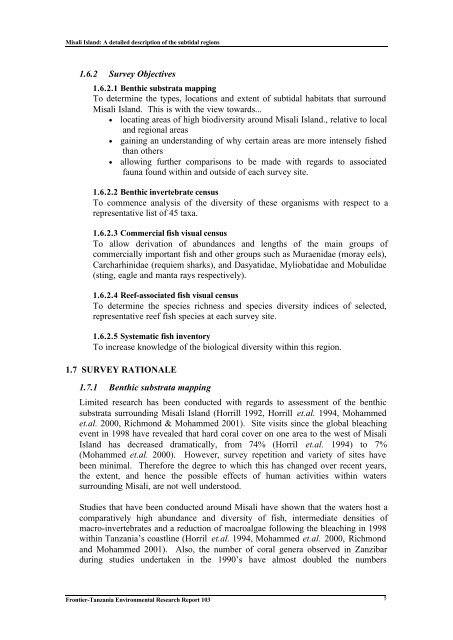Frontier-Tanzania Environmental Research REPORT 103 Misali Island
Frontier-Tanzania Environmental Research REPORT 103 Misali Island
Frontier-Tanzania Environmental Research REPORT 103 Misali Island
Create successful ePaper yourself
Turn your PDF publications into a flip-book with our unique Google optimized e-Paper software.
<strong>Misali</strong> <strong>Island</strong>: A detailed description of the subtidal regions1.6.2 Survey Objectives1.6.2.1 Benthic substrata mappingTo determine the types, locations and extent of subtidal habitats that surround<strong>Misali</strong> <strong>Island</strong>. This is with the view towards...• locating areas of high biodiversity around <strong>Misali</strong> <strong>Island</strong>., relative to localand regional areas• gaining an understanding of why certain areas are more intensely fishedthan others• allowing further comparisons to be made with regards to associatedfauna found within and outside of each survey site.1.6.2.2 Benthic invertebrate censusTo commence analysis of the diversity of these organisms with respect to arepresentative list of 45 taxa.1.6.2.3 Commercial fish visual censusTo allow derivation of abundances and lengths of the main groups ofcommercially important fish and other groups such as Muraenidae (moray eels),Carcharhinidae (requiem sharks), and Dasyatidae, Myliobatidae and Mobulidae(sting, eagle and manta rays respectively).1.6.2.4 Reef-associated fish visual censusTo determine the species richness and species diversity indices of selected,representative reef fish species at each survey site.1.6.2.5 Systematic fish inventoryTo increase knowledge of the biological diversity within this region.1.7 SURVEY RATIONALE1.7.1 Benthic substrata mappingLimited research has been conducted with regards to assessment of the benthicsubstrata surrounding <strong>Misali</strong> <strong>Island</strong> (Horrill 1992, Horrill et.al. 1994, Mohammedet.al. 2000, Richmond & Mohammed 2001). Site visits since the global bleachingevent in 1998 have revealed that hard coral cover on one area to the west of <strong>Misali</strong><strong>Island</strong> has decreased dramatically, from 74% (Horril et.al. 1994) to 7%(Mohammed et.al. 2000). However, survey repetition and variety of sites havebeen minimal. Therefore the degree to which this has changed over recent years,the extent, and hence the possible effects of human activities within waterssurrounding <strong>Misali</strong>, are not well understood.Studies that have been conducted around <strong>Misali</strong> have shown that the waters host acomparatively high abundance and diversity of fish, intermediate densities ofmacro-invertebrates and a reduction of macroalgae following the bleaching in 1998within <strong>Tanzania</strong>’s coastline (Horril et.al. 1994, Mohammed et.al. 2000, Richmondand Mohammed 2001). Also, the number of coral genera observed in Zanzibarduring studies undertaken in the 1990’s have almost doubled the numbers<strong>Frontier</strong>-<strong>Tanzania</strong> <strong>Environmental</strong> <strong>Research</strong> Report <strong>103</strong> 5
















